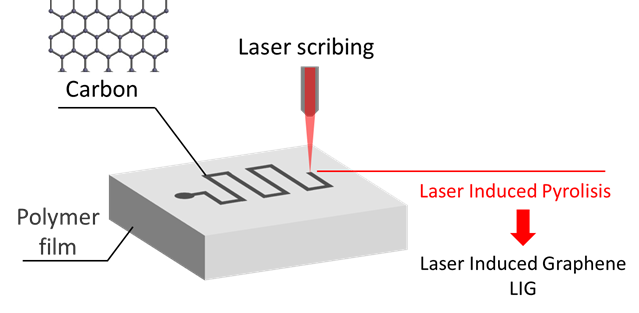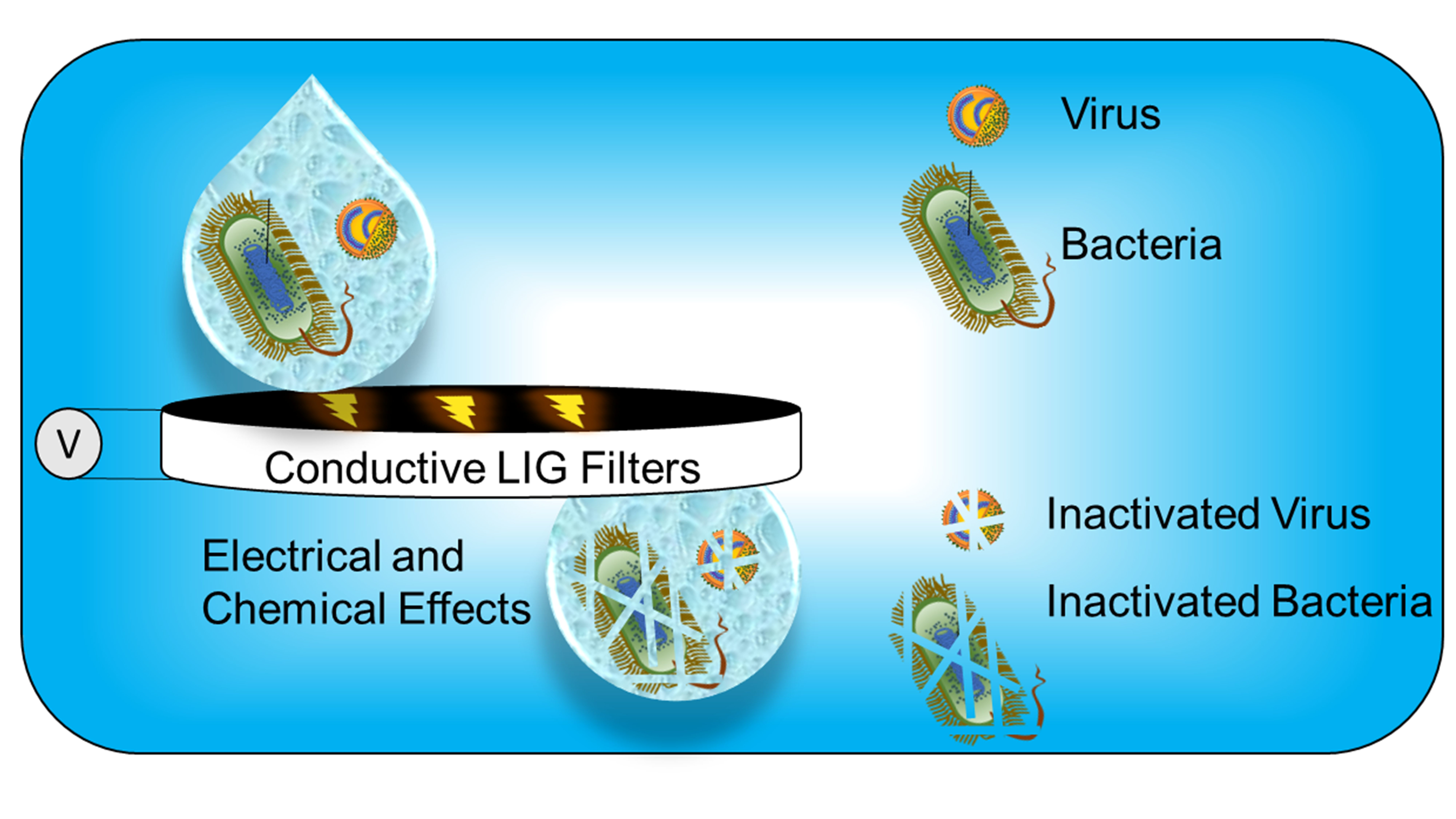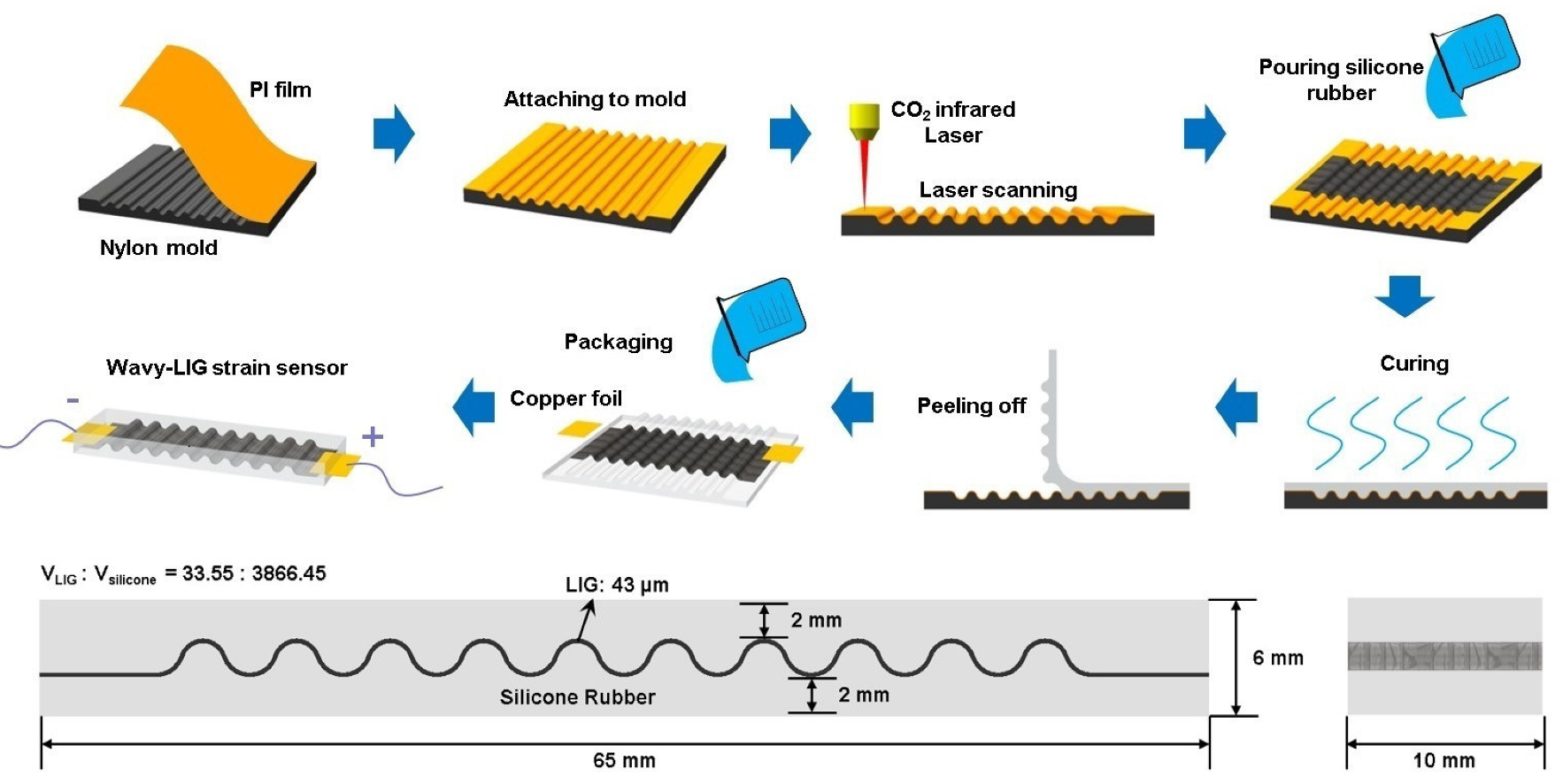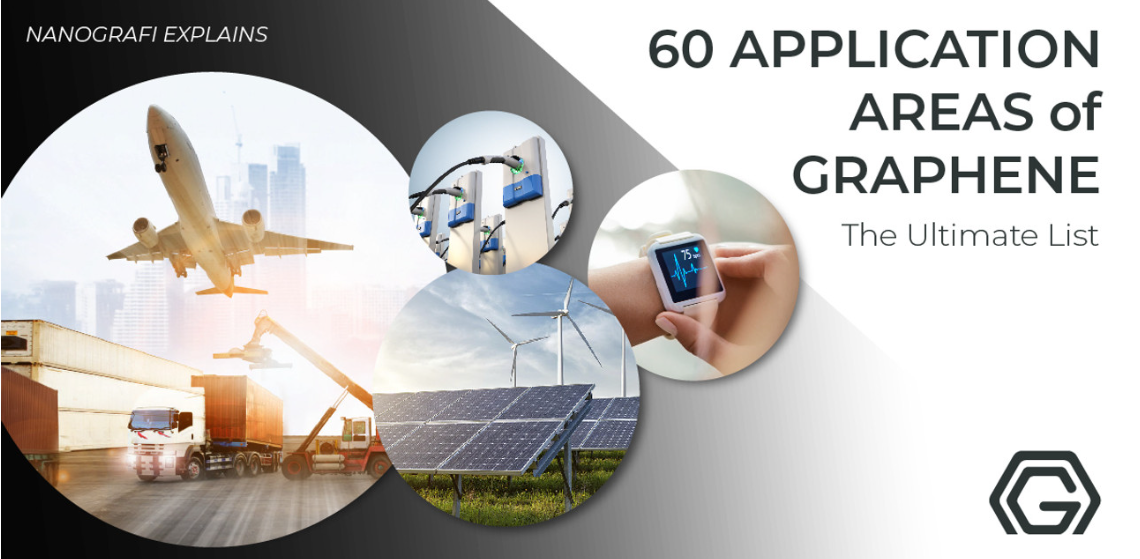Laser-Induced Graphene: Paving the Way for Innovative Implementations - Nanografi
A 3D porous substance known as laser-induced graphene (LIG) is created by directly writing carbon materials with a CO2 laser while they are in an ambient atmosphere. This method eliminates the requirement for wet chemical stages by combining the preparation and patterning of 3D graphene into a single step.
Several articles highlight the translation into numerous application fields and to outline the mechanics of the LIG-forming process. The methods that have been established to create LIG are outlined below, including the improvement in approach to transform various carbon precursors into LIG and the management of LIG attributes including porosity, content, and surface characteristics.The applications of LIG in diverse sectors, such as microfluidics, sensors, and electrocatalysts, are emphasized by utilizing the LIG features. Finally, a brief discussion of upcoming developments in biodegradable and biocompatible materials is given. Nanografi, one of the pioneering companies in the world to initiate mass production of graphene, offers high-quality graphene products to contribute to your academic research and enhance your projects.
Introduction
Due to their outstanding physical and chemical characteristics, graphene-based materials (GBMs) have recently attracted a lot of attention for their immense potential for a variety of useful devices. In recent years, laser direct writing (LDW) technology has offered a potent processing approach for the wide range of applications of laser-induced graphene (LIG) that does not rely on either high temperature or harmful chemicals.This article's objectives are to update the most recent findings in this quickly developing subject and to offer crucial insights that will spur new and interesting LIG innovations and its functionalization. We compare and contrast the various ways of preparing and functionalizing LIG, including inducing, structuring, doping, and hybriding, based on the interaction mechanisms and physical consequences. The applications of LIG and its GBMs patterned by LDW approach in the fields of optoelectronic devices, energy storage devices, biosensors, and biomimetic devices were covered in this progress report.
When laser-induced graphene was first produced from a plastic substrate in 2013 by Professor James Tour at Rice University, the wonder material's true potential became apparent. Since then, research on laser-induced graphene has led to the development of cutting-edge materials. Using the laser-induced graphene technique, numerous academic groups are doing research and creating novel applications. Among the many industries poised to help humanity, major LIG applications include air filtration, water purification, sensors, bio-sensors, flexible electronics, and energy.
Synthesis and Engineering of Laser-Induced Graphene
Since LIG requires simply a regular laser that can be found in any machine shop and no solvents or chemical reagents, it is an ecologically benign, commercially viable, and scalable method.
A 10.6 m laser photothermally warms the carbon precursor to > 2500 °C over the course of microseconds to create laser-induced graphene. As a result, non-carbon atoms rapidly outgas, and the remaining carbon is encouraged to undergo sp2 hybridization. The porosity microstructure of LIG is created as a result of the interaction between outgassing and sp2 hybridization. Graphene nanomaterial production and patterning are difficult to do economically. Our strategy resolves the problem. By employing a laser beam and commercial polymer films, LIGC develops a one-step, scalable method for fabricating and designing 3D networks of porous graphene sheets.

Figure 1. Method to produce laser-induced graphene (LIG).
Properties of Laser Induced Graphene technology:
- Conductive
- Flexible
- Anti-Microbial
- Hydrophobic
- Hydrophilic
What Role Does Laser-Induced Graphene Play in Modern Technology?
Filtration
The porous nature of laser-induced graphene makes it perfect for filtering applications. Both particles and bacteria can be effectively captured using sub-micron pore diameters. In actuality, a wide range of particle and microbe sizes can be captured by the LIG because its pore widths range from nanometers to microns. LIG has so demonstrated success in producing filtration media for the purification of both air and water. A LIG-based air filtration system has been created by LIGC Applications to collect and eliminate airborne germs, viruses, and particulates. Similar to a bug zapper, an electrical current is transmitted through the conductive graphene filtration membrane and electrocutes the trapped bacteria and viruses. They can assist you in creating a solution for your filtration needs using LIG, which may be utilized to improve a range of filtration membranes.
Water Treatment:
Recently, there has been a significant interest in understanding and preventing viral infections. In areas with biologically contaminated drinking water supplies, the development of water treatment technologies for viral inactivation or disinfection is crucial for infection control. LIG possesses antibacterial and antifouling properties due to its electrochemical characteristics and roughness. Higher voltages are required to inactivate viruses compared to bacteria. The process involves the production of reactive oxygen species and surface electrical effects. This unique feature of LIG enables its electrochemical disinfection of pathogenic microorganisms, including bacteria and viruses, in water and wastewater treatment. In summary, LIG shows promise in water treatment due to its filtration capabilities, and it can be used to develop efficient systems for water purification and disinfection.

Figure 2. Virus inactivation in water using laser-induced graphene filters.
Energy Storage
Fuel cells, electrolyzes, batteries, and other energy solutions can use LIG technology as part of their design for greater performance. LIG offers solutions for next-generation energy storage and generating devices. Nanomaterials based on carbon are essential elements in numerous energy storage applications. Carbon nanomaterials are typically employed as electrodes in supercapacitors and anodes in lithium-ion batteries. Future energy storage systems can benefit from laser-induced graphene. LIG has a huge surface area and is electrically conductive, two crucial qualities of energy storage materials. A cheap and flexible form of energy storage is made possible by the direct formation of LIG on the surface of polymeric sheets. LIG is a material that can be utilized to improve current energy storage systems and to create new, more advanced systems.
Laser-induced Graphene for Super-Capacitors
New energy storage technologies that bridge the gap between lithium-ion batteries and supercapacitors include hybrid supercapacitors. However, creating high energy cathodes for practical applications while maintaining long-term cycle stability and a high-rate capability is still a very difficult problem. In this article, we present an easy approach for synthesizing a laser-scribed graphene/LiNi1/3Mn1/3Co1/3O2 (LSG/NMC) composite for high energy cathode materials for hybrid supercapacitors. LSG/NMC composites show outstanding capacitance retention of 98.1% after 1000 cycles at a high current density of 5.0 A/g in addition to having a high capacitance of up to 141.5 F/g. An NMC spacer between the LSG layers creates a larger interspace that can serve as an effective conduit for more storage locations and quick access. They also confirmed that hybrid supercapacitors (H-HTO) with LSG/NMC cathodesand H2T12O25 anodes with an AlPO4/carbon hybrid coating layer (H-HTO) offer a remarkable 123.5 Wh/kg of energy, 14074.8 W/kg of power, and 94.6% cycle stability after 20,000 cycles. This research shows that the cathode candidate for the next-generation hybrid supercapacitors made from this suggested material is strong.
They demonstrated that hybrid supercapacitors have an outstanding energy density of 123.5 Wh/kg and a power density of 14074.8 W/kg, as well as an excellent cyclability of 94.6% after 20,000 cycles, which outperforms those of other hybrid supercapacitors. They also proposed a novel hybrid supercapacitor system based on an LSG/NMC cathode and an H-HTO anode.The following synergistic effects are primarily responsible for this extraordinary electrochemical performance: I the LSG's inherent excellent electrochemical performance;
- the anchoring of NMC spacers between the LSG layers, which caused segregated graphene,
- the increase in capacitance caused by the additional effects of the NMC pseudocapacitive reaction
- the combination of tunnels and rapid pathways (hybrid coating) in the HTO anode These results point to the possibility of a hybrid supercapacitor utilising the LSG/NMC/H-HTO system as a potent and efficient tool for exceptional performance.
Laser-induced Graphene for Batteries
Due to its versatility, low cost, and ease of use, laser irradiation is emerging as a feasible method for producing 3D graphene. Here, the focus is on the newly developed uses of laser-induced graphene (LIG) in batteries. In addition to having a binder-free self-supported electrode arrangement, this form of 3D graphitic carbon also has high electrical and ionic conductivity, hierarchical porosity, and tunable composition after laser exposure.The development of LIG synthesis and its advancement for battery applications are thoroughly reviewed and addressed. Included in this are the applications of LIG as an electrode for lithium- and sodium-ion batteries, a current collector for lithium-metal batteries, an electrocatalyst for metal-air batteries, and a host and interlayer for lithium-sulfur batteries. We offer innovative solutions to improve battery performance and extend battery life. Visit Nanografi to purchase the battery materials you need.
Sensor Platform
The LIG's broad surface area, electrical conductivity, ease of manufacture, and biocidal nature make it possible to create low-cost sensors and biosensors with excellent performance. In the modern world, smart technologies enable us to keep an almost constant eye on our surroundings and health. To gather information that will allow us to make wise judgements, these smart devices rely on sensors. Therefore, it is critical to have sensor platforms that are reliable, sturdy, and adaptable so that they may be utilized for a number of applications. The appropriate material for the creation of sensor technologies is laser-induced graphene. Particularly, LIG is conductive, allowing for electronic monitoring of LIG-based sensors. Another suitable sensing platform trait is that LIG has a very high surface area, which makes it very responsive to its surroundings. Last but not least, LIG is easily functionalized to identify particular compounds and biological species. customized throughput sensors for your requirements.
The creation of a series of LIG sensors is encouraged by the low cost of LIG technology and its ease of synthesis, making it a possible option for industrial manufacturing. A wide variety of stimuli, including different chemicals as well as sounds, vibrations, and temperature, have been recognized thanks to the rational design of sensing mechanisms. Due to the huge surface area and chemical stability of LIG, these sensors frequently exhibit great sensitivity and stability. LIG is a perfect transducer for translating inputs into electrical signals due to its high conductivity. Polymer-based pure LIG is frequently flexible and can transfer to different substrates.

Figure 3. Wearable flexible strain sensor based on three-Dimensional wavy laser-induced graphene and silicone rubber.
Surfaces And Functional Composites
Laser-induced graphene can be included into composites to increase strength, heat transfer, electrical conductivity, and antibacterial characteristics. Composites can incorporate LIG to improve functionality. Through the use of unique embedding techniques, LIG can be combined with several polymers, epoxies, and sturdy building supplies like cement to create composites. LIG can be added to materials to improve their mechanical qualities while also making them electrically conductive. LIG composites also have anti-microbial properties that stop bacteria from growing unintentionally. LIG has so far been utilized to create composites from a variety of materials. LIG can specifically be buried in concrete to function as a heater for deicing. LIG has been used to stop clogging and biofouling in water filters. In order to increase mechanical durability and electrical conductivity, LIG has also been used into epoxies.
To discover about all the uses and applications of graphene, you can read our most popular blog.
Conclusion
Due to its distinct two-dimensional structure and superior physical and chemical characteristics, graphene has been considered a promising application material in the field of novel energy conversion and storage. However, the in-process complexity of conventional graphene preparation techniques makes it challenging to build patterned structures. Researchers have been paying a lot of attention lately to laser-induced graphene (LIG) technology, which has a variety of uses in supercapacitors, batteries, sensors, air filters, water treatment, etc. We compiled a number of graphene preparation techniques in this article. On the prepared LIG's properties, the effects of the laser's processing parameters, laser type, precursor materials, and process atmosphere were examined.Then, two methods for producing LIG on a big scale were briefly explained. The several uses of LIG in the areas of signal detecting, environmental protection, and energy storage were also covered. Finally, we gave a quick overview of this technology’s potential future directions. At Nanografi, we follow the potential groundbreaking applications in future technologies and contribute to their development every day.
References
60 Uses and Applications of Graphene – Nanografi - Nanografi Nano Technology. (n.d.). Retrieved March 20, 2024, from https://nanografi.com/blog/60-uses-and-applications-of-graphene-nanografi-/
Alhajji, E., Zhang, F., & Alshareef, H. N. (2021). Status and Prospects of Laser-Induced Graphene for Battery Applications. Energy Technology, 9(10), 2100454. https://doi.org/10.1002/ENTE.202100454
Applications of LIG in various biosensors and physical physiological... | Download Scientific Diagram. (n.d.). Retrieved March 20, 2024, from https://www.researchgate.net/figure/Applications-of-LIG-in-various-biosensors-and-physical-physiological-sensors_fig1_357735048
Barbhuiya, N. H., Kumar, A., & Singh, S. P. (2021). A Journey of Laser-Induced Graphene in Water Treatment. Transactions of the Indian National Academy of Engineering, 6(2), 159–171. https://doi.org/10.1007/S41403-021-00205-2
Barbhuiya, N. H., Singh, S. P., Makovitzki, A., Narkhede, P., Oren, Z., Adar, Y., Lupu, E., Cherry, L., Monash, A., & Arnusch, C. J. (2021a). Virus inactivation in water using laser-induced graphene filters. Materials, 14(12), 3179. https://doi.org/10.3390/MA14123179/S1
Barbhuiya, N. H., Singh, S. P., Makovitzki, A., Narkhede, P., Oren, Z., Adar, Y., Lupu, E., Cherry, L., Monash, A., & Arnusch, C. J. (2021b). Virus inactivation in water using laser-induced graphene filters. Materials, 14(12), 3179. https://doi.org/10.3390/MA14123179/S1
Dixit, N., & Singh, S. P. (2022). Laser-Induced Graphene (LIG) as a Smart and Sustainable Material to Restrain Pandemics and Endemics: A Perspective. ACS Omega, 7(6), 5112–5130. https://doi.org/10.1021/ACSOMEGA.1C06093/ASSET/IMAGES/LARGE/AO1C06093_0008.JPEG
Enhancing Thermal Energy Storage with Nanoparticles - Nanografi Nano Technology. (n.d.). Retrieved March 20, 2024, from https://nanografi.com/blog/enhancing-thermal-energy-storage-with-nanoparticles/
Graphene Sheet Uses - Nanografi Nano Technology. (n.d.). Retrieved March 20, 2024, from https://nanografi.com/blog/graphene-sheet-uses/
Graphene Water Filtration - Nanografi Nano Technology. (n.d.). Retrieved March 20, 2024, from https://nanografi.com/blog/graphene-water-filtration/
Guo, Y., Zhang, C., Chen, Y., & Nie, Z. (2022). Research Progress on the Preparation and Applications of Laser-Induced Graphene Technology. Nanomaterials (Basel, Switzerland), 12(14). https://doi.org/10.3390/NANO12142336
Huang, L., Su, J., Song, Y., & Ye, R. (2020). Laser-Induced Graphene: En Route to Smart Sensing. Nano-Micro Letters, 12(1), 1–17. https://doi.org/10.1007/S40820-020-00496-0/FIGURES/8
Huang, L., Wang, H., Wu, P., Huang, W., Gao, W., Fang, F., Cai, N., Chen, R., & Zhu, Z. (2020). Wearable Flexible Strain Sensor Based on Three-Dimensional Wavy Laser-Induced Graphene and Silicone Rubber. Sensors 2020, Vol. 20, Page 4266, 20(15), 4266. https://doi.org/10.3390/S20154266
Laser Induced Graphene – LAMPSe | Greco Group Graz. (n.d.). Retrieved March 20, 2024, from https://lampselab.com/current-research-projects/laser-induced-graphene-studies/
Laser-Induced Graphene Composites as Multifunctional Surfaces | Request PDF. (n.d.). Retrieved March 20, 2024, from https://www.researchgate.net/publication/330951066_Laser-Induced_Graphene_Composites_as_Multifunctional_Surfaces
Lee, S. H., Kim, K. Y., & Yoon, J. R. (2020). Binder- and conductive additive-free laser-induced graphene/LiNi1/3Mn1/3Co1/3O2 for advanced hybrid supercapacitors. NPG Asia Materials 2020 12:1, 12(1), 1–15. https://doi.org/10.1038/s41427-020-0204-0
Porous Metallic Foams as an Electrode for Supercapacitor Applications - Nanografi Nano Technology. (n.d.). Retrieved March 20, 2024, from https://nanografi.com/blog/porous-metallic-foams-as-an-electrode-for-supercapacitor-applications-f0439f/
Wang, F., Wang, K., Zheng, B., Dong, X., Mei, X., Lv, J., Duan, W., & Wang, W. (2018). Laser-induced graphene: preparation, functionalization and applications. Materials Technology, 33(5), 340–356. https://doi.org/10.1080/10667857.2018.1447265
What is Graphene: The Ultimate Guide - Nanografi Nano Technology. (n.d.). Retrieved March 20, 2024, from https://nanografi.com/blog/what-is-graphene-the-ultimate-guide/
Recent Posts
-
Cellulose Nanocrystals (CNC) in Food Industry
Cellulose nanocrystals (CNC) are emerging as a pivotal material in the realm of food technology, her …3rd May 2024 -
Reducing the Carbon Footprint of Nanomaterials
The production of nanomaterials is vital for numerous advanced applications, from healthcare to elec …26th Apr 2024 -
Nanocomposites in Food Packaging
The utilization of nanocomposites in food packaging represents a significant advancement in the fiel …19th Apr 2024







